Evolutionary Impacts of Pattern Recognition Receptor Genes on Carnivora Complex Habitat Stress Adaptation
Abstract
Simple Summary
Abstract
1. Introduction
2. Materials and Methods
2.1. Taxon Coverage and Dataset Preparation
2.2. Identification of Pattern Recognition Receptor Genes
2.3. Phylogenetic Tree Construction
2.4. Molecular Evolutionary Analyses
2.5. Identifying Functional Domains and Predicting Three-Dimensional Protein Structures
3. Results
3.1. Acquisition of PRR Genes by Carnivora Species
3.2. Phylogenetic Analysis
3.3. Analysis of PPR Gene Selection Pressure
3.3.1. Site Model Analysis
3.3.2. Branch-Model Analysis
3.3.3. Branch-Site Model Analysis
3.3.4. Clade Model Analysis
3.4. Annotation of the Positively Selected Sites of Three-Dimensional Protein Structures
4. Discussion
4.1. Relaxed Selective Pressure of the TLR10 Gene
4.2. Differences in the Evolution of Different Carnivora PRR Subfamilies
4.3. Carnivora PRR Genes Universally Underwent Positive Selection
4.4. Evolutionary Relationship between Niches and PRR Genes
5. Conclusions
Supplementary Materials
Author Contributions
Funding
Institutional Review Board Statement
Data Availability Statement
Conflicts of Interest
References
- Burgin, C.J.; Colella, J.P.; Kahn, P.L.; Upham, N.S. How many species of mammals are there? J. Mammal. 2018, 99, 1–14. [Google Scholar] [CrossRef]
- Heinrich, R.E.; Strait, S.G.; Houde, P. Earliest Eocene Miacidae (Mammalia: Carnivora) from northwestern Wyoming. J. Paleontol. 2008, 82, 154–162. [Google Scholar] [CrossRef]
- Kawai, T.; Akira, S. The roles of TLRs, RLRs and NLRs in pathogen recognition. Int. Immunol. 2009, 21, 317–337. [Google Scholar]
- Wicherska-Pawłowska, K.; Wróbel, T.; Rybka, J. Toll-Like Receptors (TLRs), NOD-Like Receptors (NLRs), and RIG-I-Like Receptors (RLRs) in Innate Immunity. TLRs, NLRs, and RLRs Ligands as Immunotherapeutic Agents for Hematopoietic Diseases. Int. J. Mol. Sci. 2021, 22, 13397. [Google Scholar] [CrossRef] [PubMed]
- Kumar, H.; Kawai, T.; Akira, S. Pathogen recognition by the innate immune system. Int. Rev. Immunol. 2011, 30, 16–34. [Google Scholar] [CrossRef] [PubMed]
- Sang, Y.; Shi, J.; Sang, W.; Rowland, R.R.; Blecha, F. Replication-competent recombinant porcine reproductive and respiratory syndrome (PRRS) viruses expressing indicator proteins and antiviral cytokines. Viruses 2012, 4, 102–116. [Google Scholar] [CrossRef]
- Matsumoto, M.; Seya, T. TLR3: Interferon induction by double-stranded RNA including poly(I:C). Adv. Drug Deliv. Rev. 2008, 60, 805–812. [Google Scholar] [CrossRef]
- Mazgaeen, L.; Gurung, P. Recent Advances in Lipopolysaccharide Recognition Systems. Int. J. Mol. Sci. 2020, 21, 379. [Google Scholar] [CrossRef]
- Sato, K.; Ishikawa, T.; Okumura, A.; Yamauchi, T.; Sato, S.; Ayada, M.; Matsumoto, E.; Hotta, N.; Oohashi, T.; Fukuzawa, Y.; et al. Expression of Toll-like receptors in chronic hepatitis C virus infection. J. Gastroenterol. Hepatol. 2007, 22, 1627–1632. [Google Scholar] [CrossRef]
- Altschul, S.F.; Madden, T.L.; Schäffer, A.A.; Zhang, J.; Zhang, Z.; Miller, W.; Lipman, D.J. Gapped BLAST and PSI-BLAST: A new generation of protein database search programs. Nucleic Acids Res. 1997, 25, 3389–3402. [Google Scholar] [CrossRef]
- Chen, C.; Chen, H.; Zhang, Y.; Thomas, H.R.; Frank, M.H.; He, Y.; Xia, R. TBtools: An Integrative Toolkit Developed for Interactive Analyses of Big Biological Data. Mol. Plant 2020, 13, 1194–1202. [Google Scholar] [CrossRef] [PubMed]
- Kumar, S.; Stecher, G.; Li, M.; Knyaz, C.; Tamura, K. MEGA X: Molecular Evolutionary Genetics Analysis across Computing Platforms. Mol. Biol. Evol. 2018, 35, 1547–1549. [Google Scholar] [CrossRef] [PubMed]
- de Ferran, V.; Figueiró, H.V.; de Jesus Trindade, F.; Smith, O.; Sinding, M.S.; Trinca, C.S.; Lazzari, G.Z.; Veron, G.; Vianna, J.A.; Barbanera, F.; et al. Phylogenomics of the world’s otters. Curr. Biol. 2022, 32, 3650–3658.e4. [Google Scholar] [CrossRef] [PubMed]
- Robbins, C.T.; Tollefson, T.N.; Rode, K.D.; Erlenbach, J.A.; Ardente, A.J. New insights into dietary management of polar bears (Ursus maritimus) and brown bears (U. arctos). Zoo Biol. 2022, 41, 166–175. [Google Scholar] [CrossRef] [PubMed]
- Leahy, A.M.; Fish, F.E.; Kerr, S.J.; Zeligs, J.A.; Skrovan, S.; Cardenas, K.L.; Leftwich, M.C. The role of California sea lion (Zalophus californianus) hindflippers as aquatic control surfaces for maneuverability. J. Exp. Biol. 2021, 224, jeb243020. [Google Scholar] [CrossRef]
- Madeira, F.; Park, Y.M.; Lee, J.; Buso, N.; Gur, T.; Madhusoodanan, N.; Basutkar, P.; Tivey, A.R.N.; Potter, S.C.; Finn, R.D.; et al. The EMBL-EBI search and sequence analysis tools APIs in 2019. Nucleic Acids Res. 2019, 47, W636–W641. [Google Scholar] [CrossRef]
- Castresana, J. Selection of conserved blocks from multiple alignments for their use in phylogenetic analysis. Mol. Biol. Evol. 2000, 17, 540–552. [Google Scholar] [CrossRef]
- Nguyen, L.T.; Schmidt, H.A.; von Haeseler, A.; Minh, B.Q. IQ-TREE: A fast and effective stochastic algorithm for estimating maximum-likelihood phylogenies. Mol. Biol. Evol. 2015, 32, 268–274. [Google Scholar] [CrossRef]
- Letunic, I.; Bork, P. Interactive Tree Of Life (iTOL) v5: An online tool for phylogenetic tree display and annotation. Nucleic Acids Res. 2021, 49, W293–W296. [Google Scholar] [CrossRef]
- Yang, Z. PAML 4: Phylogenetic analysis by maximum likelihood. Mol. Biol. Evol. 2007, 24, 1586–1591. [Google Scholar] [CrossRef]
- Weadick, C.J.; Chang, B.S. An improved likelihood ratio test for detecting site-specific functional divergence among clades of protein-coding genes. Mol. Biol. Evol. 2012, 29, 1297–1300. [Google Scholar] [CrossRef] [PubMed]
- Letunic, I.; Bork, P. 20 years of the SMART protein domain annotation resource. Nucleic Acids Res. 2018, 46, D493–D496. [Google Scholar] [CrossRef] [PubMed]
- Roy, A.; Kucukural, A.; Zhang, Y. I-TASSER: A unified platform for automated protein structure and function prediction. Nat. Protoc. 2010, 5, 725–738. [Google Scholar] [CrossRef] [PubMed]
- Roach, J.C.; Glusman, G.; Rowen, L.; Kaur, A.; Purcell, M.K.; Smith, K.D.; Hood, L.E.; Aderem, A. The evolution of vertebrate Toll-like receptors. Proc. Natl. Acad. Sci. USA 2005, 102, 9577–9582. [Google Scholar] [CrossRef] [PubMed]
- Oosting, M.; Cheng, S.C.; Bolscher, J.M.; Vestering-Stenger, R.; Plantinga, T.S.; Verschueren, I.C.; Arts, P.; Garritsen, A.; van Eenennaam, H.; Sturm, P.; et al. Human TLR10 is an anti-inflammatory pattern-recognition receptor. Proc. Natl. Acad. Sci. USA 2014, 111, E4478–E4484. [Google Scholar] [CrossRef] [PubMed]
- Yuen, B.; Bayes, J.M.; Degnan, S.M. The characterization of sponge NLRs provides insight into the origin and evolution of this innate immune gene family in animals. Mol. Biol. Evol. 2014, 31, 106–120. [Google Scholar] [CrossRef]
- Quintana-Murci, L.; Clark, A.G. Population genetic tools for dissecting innate immunity in humans. Nat. Rev. Immunol. 2013, 13, 280–293. [Google Scholar]
- Chen, J.; Shang, S.; Wu, X.; Zhong, H.; Zhao, C.; Wei, Q.; Zhang, H.; Xia, T.; Chen, Y.; Zhang, H.; et al. Genomic analysis and adaptive evolution of the RIG-I-like and NOD-like receptors in reptiles. Int. J. Biol. Macromol. 2019, 134, 1045–1051. [Google Scholar] [CrossRef]
- Wlasiuk, G.; Nachman, M.W. Adaptation and constraint at Toll-like receptors in primates. Mol. Biol. Evol. 2010, 27, 2172–2186. [Google Scholar] [CrossRef]
- Miller, S.I.; Ernst, R.K.; Bader, M.W. LPS, TLR4 and infectious disease diversity. Nat. Rev. Microbiol. 2005, 3, 36–46. [Google Scholar] [CrossRef]
- Alcaide, M.; Edwards, S.V. Molecular evolution of the toll-like receptor multigene family in birds. Mol. Biol. Evol. 2011, 28, 1703–1715. [Google Scholar] [CrossRef] [PubMed]
- Jin, M.S.; Lee, J.O. Structures of the toll-like receptor family and its ligand complexes. Immunity 2008, 29, 182–191. [Google Scholar] [CrossRef] [PubMed]
- Fitzgerald, K.A.; Kagan, J.C. Toll-like Receptors and the Control of Immunity. Cell 2020, 180, 1044–1066. [Google Scholar] [CrossRef] [PubMed]
- Kawai, T.; Akira, S. The role of pattern-recognition receptors in innate immunity: Update on Toll-like receptors. Nat. Immunol. 2010, 11, 373–384. [Google Scholar] [CrossRef]
- Park, B.S.; Song, D.H.; Kim, H.M.; Choi, B.-S.; Lee, H.; Lee, J.-O. The structural basis of lipopolysaccharide recognition by the TLR4–MD-2 complex. Nature 2009, 458, 1191–1195. [Google Scholar] [CrossRef]
- Ferwerda, B.; McCall, M.B.B.; Alonso, S.; Giamarellos-Bourboulis, E.J.; Mouktaroudi, M.; Izagirre, N.; Syafruddin, D.; Kibiki, G.; Cristea, T.; Hijmans, A.; et al. TLR4 polymorphisms, infectious diseases, and evolutionary pressure during migration of modern humans. Proc. Natl. Acad. Sci. USA 2007, 104, 16645–16650. [Google Scholar] [CrossRef]
- Velová, H.; Gutowska-Ding, M.W.; Burt, D.W.; Vinkler, M. Toll-Like Receptor Evolution in Birds: Gene Duplication, Pseudogenization, and Diversifying Selection. Mol. Biol. Evol. 2018, 35, 2170–2184. [Google Scholar] [CrossRef]
- Barreiro, L.B.; Ben-Ali, M.; Quach, H.; Laval, G.; Patin, E.; Pickrell, J.K.; Bouchier, C.; Tichit, M.; Neyrolles, O.; Gicquel, B.; et al. Evolutionary dynamics of human Toll-like receptors and their different contributions to host defense. PLoS Genet. 2009, 5, e1000562. [Google Scholar] [CrossRef]
- Areal, H.; Abrantes, J.; Esteves, P.J. Signatures of positive selection in Toll-like receptor (TLR) genes in mammals. BMC Evol. Biol. 2011, 11, 368. [Google Scholar] [CrossRef]
- Escalera-Zamudio, M.; Zepeda-Mendoza, M.L.; Loza-Rubio, E.; Rojas-Anaya, E.; Méndez-Ojeda, M.L.; Arias, C.F.; Greenwood, A.D. The evolution of bat nucleic acid-sensing Toll-like receptors. Mol. Ecol. 2015, 24, 5899–5909. [Google Scholar] [CrossRef]
- Heil, F.; Hemmi, H.; Hochrein, H.; Ampenberger, F.; Kirschning, C.; Akira, S.; Lipford, G.; Wagner, H.; Bauer, S. Species-specific recognition of single-stranded RNA via toll-like receptor 7 and 8. Science 2004, 303, 1526–1529. [Google Scholar] [CrossRef] [PubMed]
- Zhang, Y.; El-Far, M.; Dupuy, F.P.; Abdel-Hakeem, M.S.; He, Z.; Procopio, F.A.; Shi, Y.; Haddad, E.K.; Ancuta, P.; Sekaly, R.P.; et al. HCV RNA Activates APCs via TLR7/TLR8 While Virus Selectively Stimulates Macrophages Without Inducing Antiviral Responses. Sci. Rep. 2016, 6, 29447. [Google Scholar] [CrossRef] [PubMed]
- Lemos de Matos, A.; McFadden, G.; Esteves, P.J. Positive evolutionary selection on the RIG-I-like receptor genes in mammals. PLoS ONE 2013, 8, e81864. [Google Scholar]
- Arrese, M.; Cabrera, D.; Kalergis, A.M.; Feldstein, A.E. Innate Immunity and Inflammation in NAFLD/NASH. Dig. Dis. Sci. 2016, 61, 1294–1303. [Google Scholar] [CrossRef] [PubMed]
- Franchi, L.; Warner, N.; Viani, K.; Nuñez, G. Function of Nod-like receptors in microbial recognition and host defense. Immunol. Rev. 2009, 227, 106–128. [Google Scholar] [CrossRef]
- Zhen, Y.; Zhang, H. NLRP3 Inflammasome and Inflammatory Bowel Disease. Front. Immunol. 2019, 10, 276. [Google Scholar] [CrossRef]
- Neerincx, A.; Lautz, K.; Menning, M.; Kremmer, E.; Zigrino, P.; Hösel, M.; Büning, H.; Schwarzenbacher, R.; Kufer, T.A. A role for the human nucleotide-binding domain, leucine-rich repeat-containing family member NLRC5 in antiviral responses. J. Biol. Chem. 2010, 285, 26223–26232. [Google Scholar] [CrossRef]
- Staehli, F.; Ludigs, K.; Heinz, L.X.; Seguín-Estévez, Q.; Ferrero, I.; Braun, M.; Schroder, K.; Rebsamen, M.; Tardivel, A.; Mattmann, C.; et al. NLRC5 deficiency selectively impairs MHC class I- dependent lymphocyte killing by cytotoxic T cells. J. Immunol. 2012, 188, 3820–3828. [Google Scholar] [CrossRef]
- Cui, J.; Zhu, L.; Xia, X.; Wang, H.Y.; Legras, X.; Hong, J.; Ji, J.; Shen, P.; Zheng, S.; Chen, Z.J.; et al. NLRC5 negatively regulates the NF-kappaB and type I interferon signaling pathways. Cell 2010, 141, 483–496. [Google Scholar] [CrossRef]
- Tian, R.; Chen, M.; Chai, S.; Rong, X.; Chen, B.; Ren, W.; Xu, S.; Yang, G. Divergent Selection of Pattern Recognition Receptors in Mammals with Different Ecological Characteristics. J. Mol. Evol. 2018, 86, 138–149. [Google Scholar] [CrossRef]
- Ley, R.E.; Hamady, M.; Lozupone, C.; Turnbaugh, P.J.; Ramey, R.R.; Bircher, J.S.; Schlegel, M.L.; Tucker, T.A.; Schrenzel, M.D.; Knight, R.; et al. Evolution of mammals and their gut microbes. Science 2008, 320, 1647–1651. [Google Scholar] [CrossRef] [PubMed]
- Bik, E.M.; Costello, E.K.; Switzer, A.D.; Callahan, B.J.; Holmes, S.P.; Wells, R.S.; Carlin, K.P.; Jensen, E.D.; Venn-Watson, S.; Relman, D.A. Marine mammals harbor unique microbiotas shaped by and yet distinct from the sea. Nat. Commun. 2016, 7, 10516. [Google Scholar] [CrossRef] [PubMed]
- Hennessy, M.B.; Deak, T.; Schiml, P.A. Sociality and sickness: Have cytokines evolved to serve social functions beyond times of pathogen exposure? Brain Behav. Immun. 2014, 37, 15–20. [Google Scholar] [CrossRef] [PubMed]
- Shishido, R.; Ohishi, K.; Suzuki, R.; Takishita, K.; Ohtsu, D.; Okutsu, K.; Tokutake, K.; Katsumata, E.; Bando, T.; Fujise, Y.; et al. Cetacean Toll-like receptor 4 and myeloid differentiation factor 2, and possible cetacean-specific responses against Gram-negative bacteria. Comp. Immunol. Microbiol. Infect. Dis 2010, 33, e89–e98. [Google Scholar] [CrossRef]
- Shen, T.; Xu, S.; Wang, X.; Yu, W.; Zhou, K.; Yang, G. Adaptive evolution and functional constraint at TLR4 during the secondary aquatic adaptation and diversification of cetaceans. BMC Evol. Biol. 2012, 12, 39. [Google Scholar] [CrossRef] [PubMed]
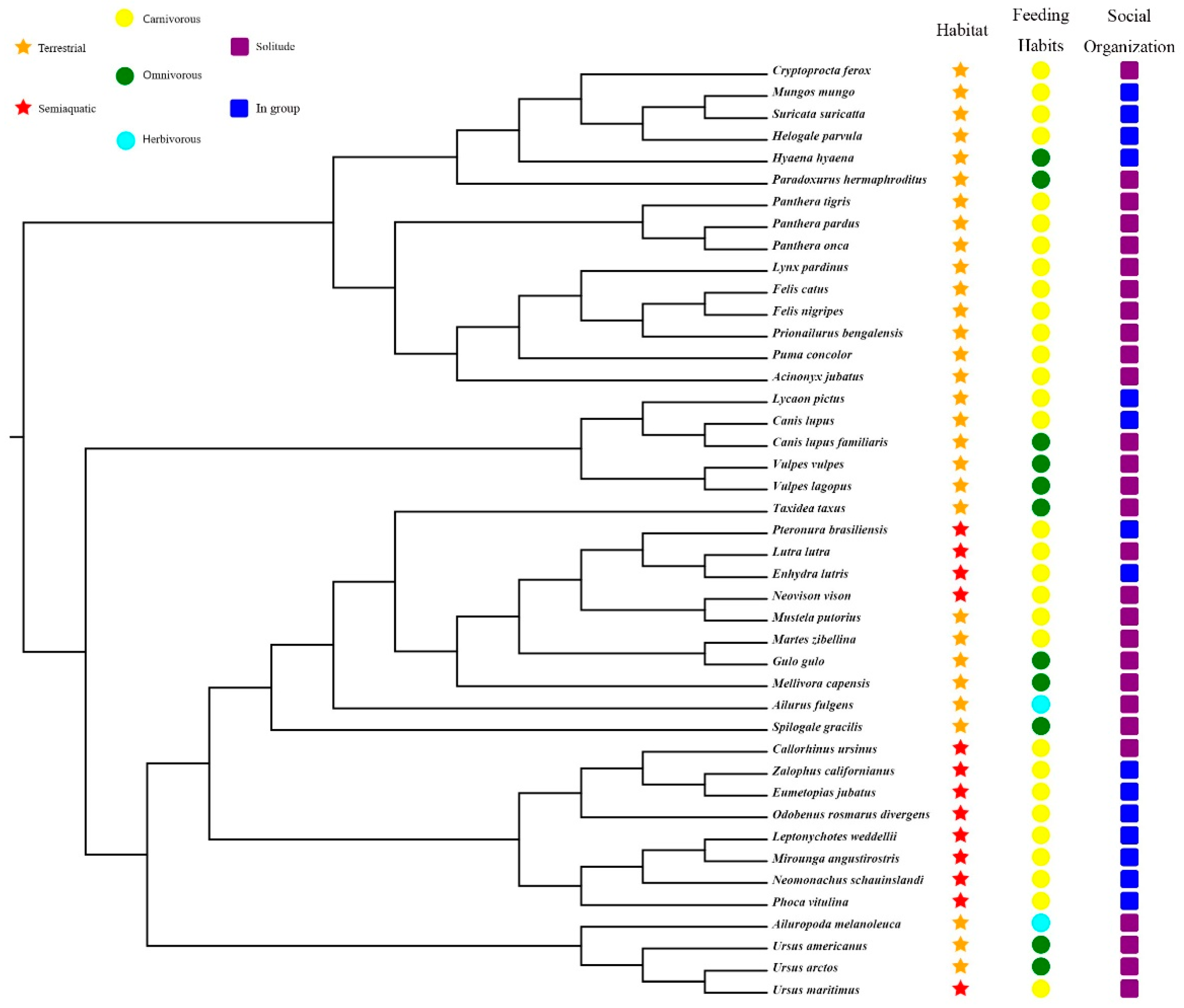
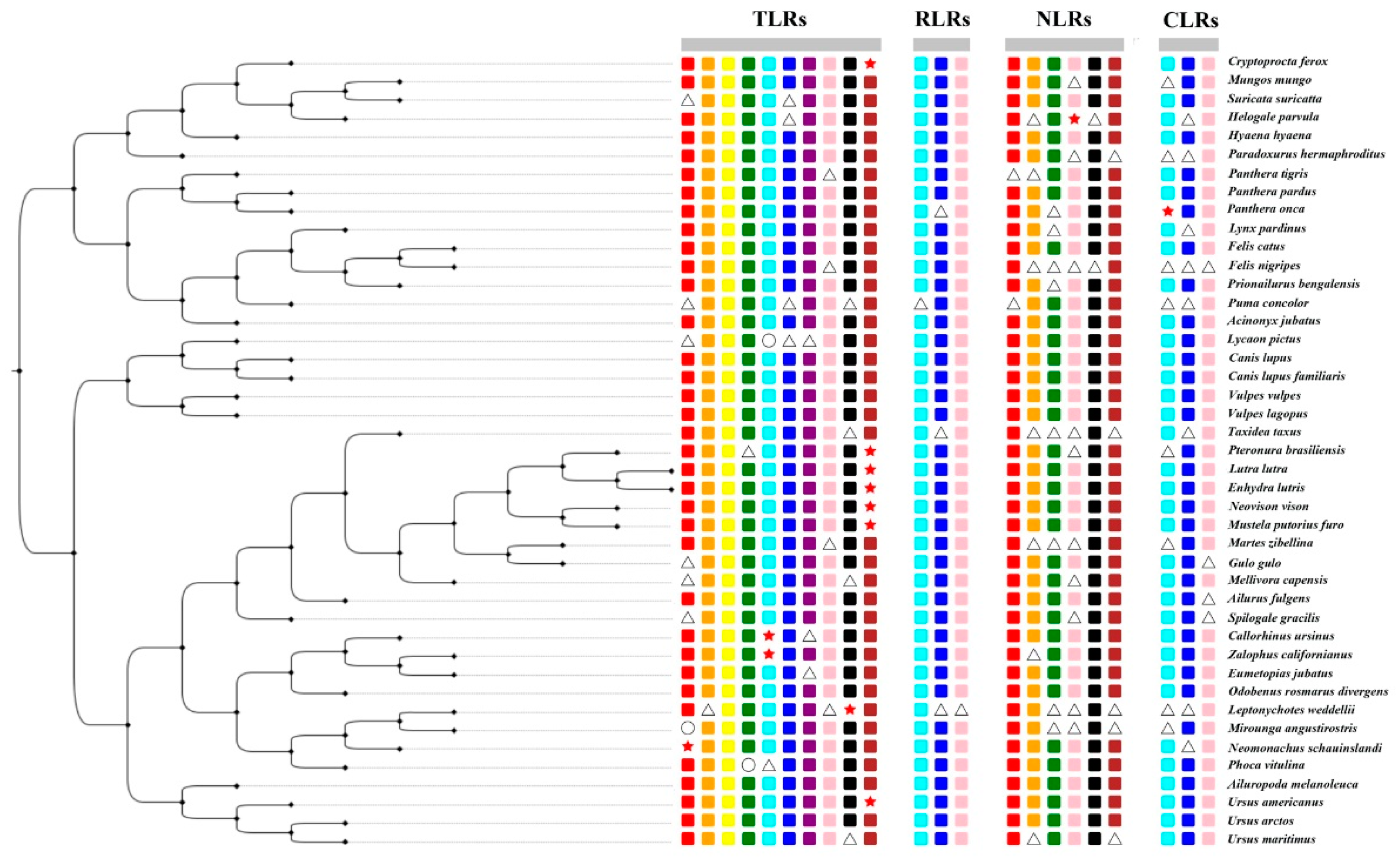

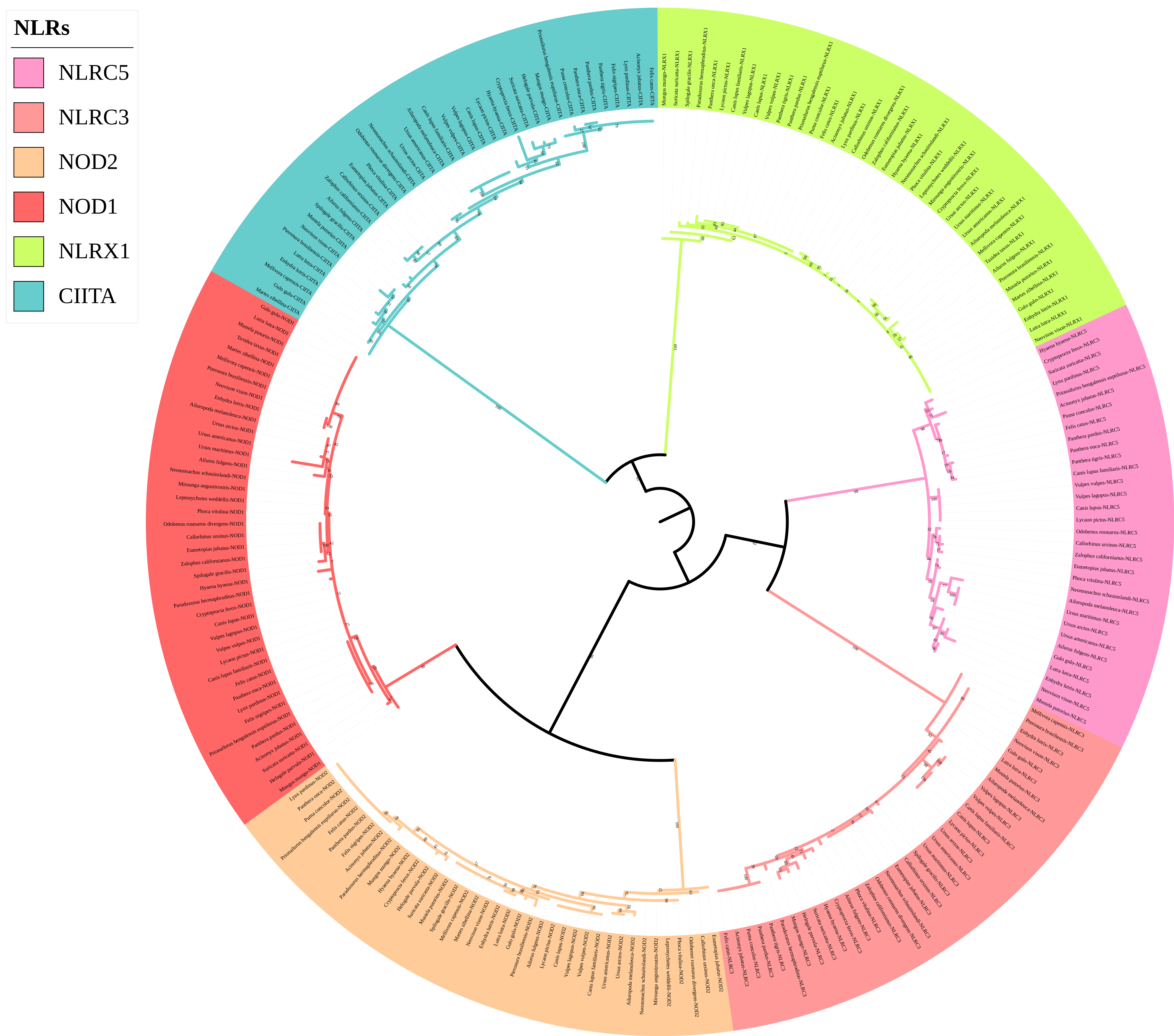
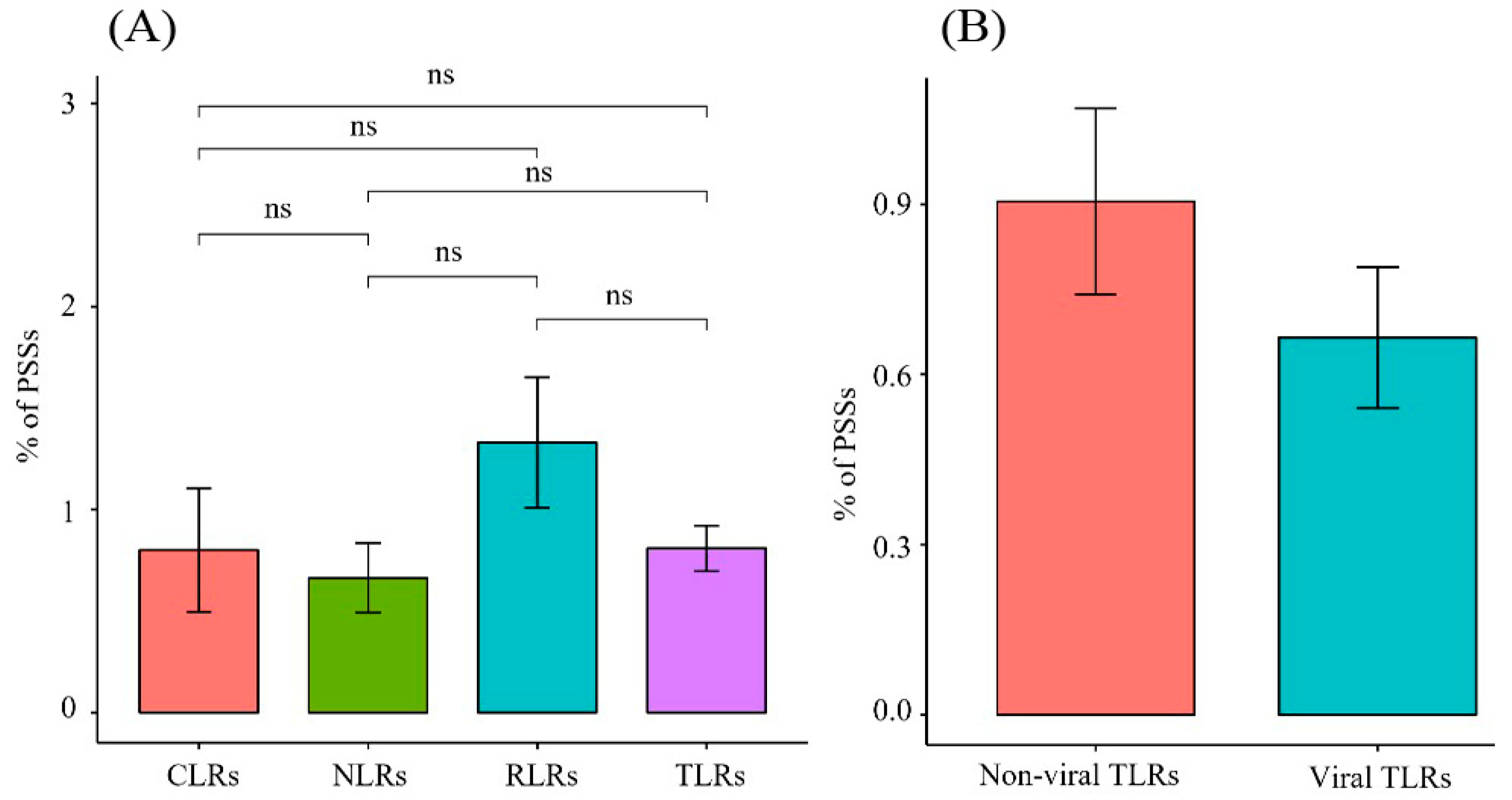

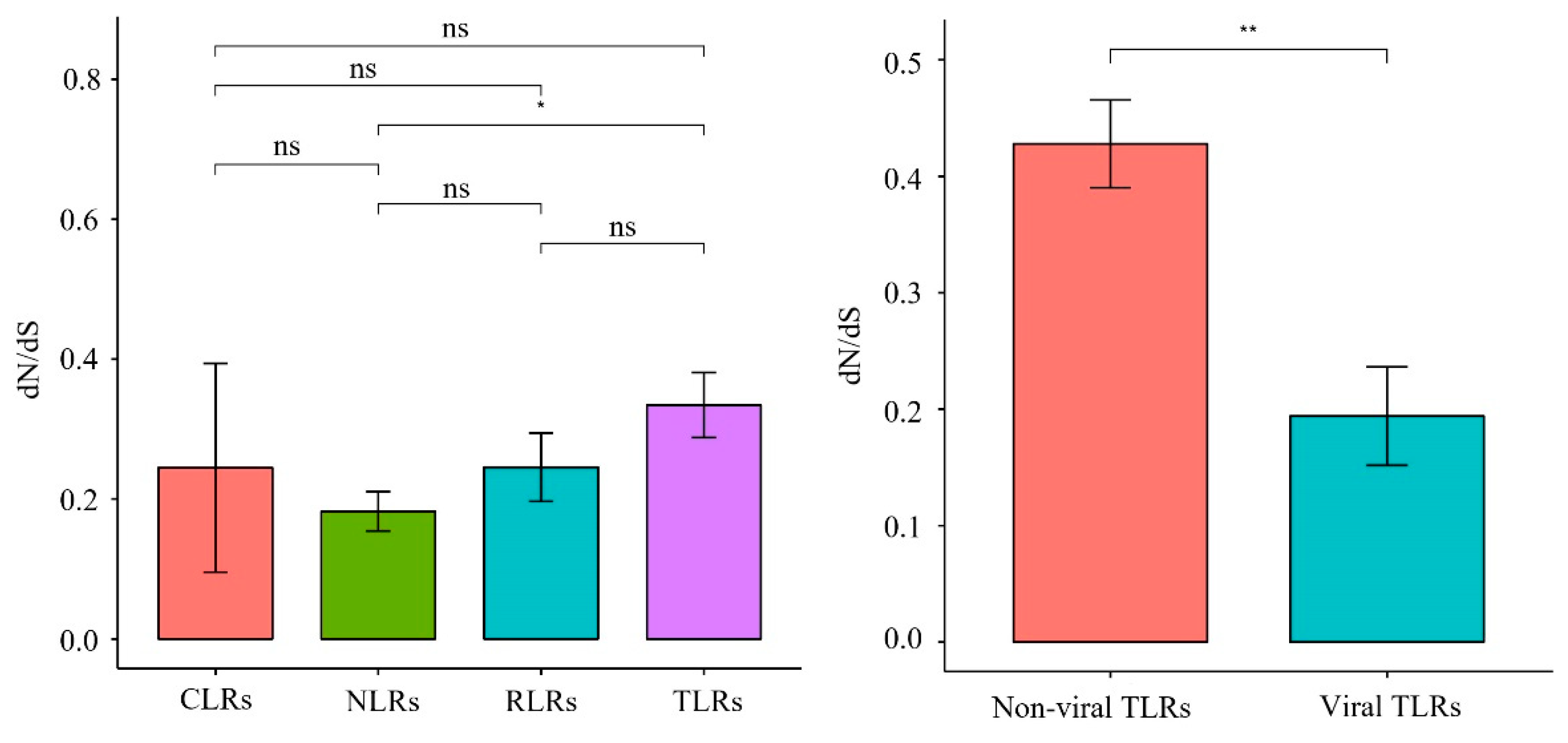
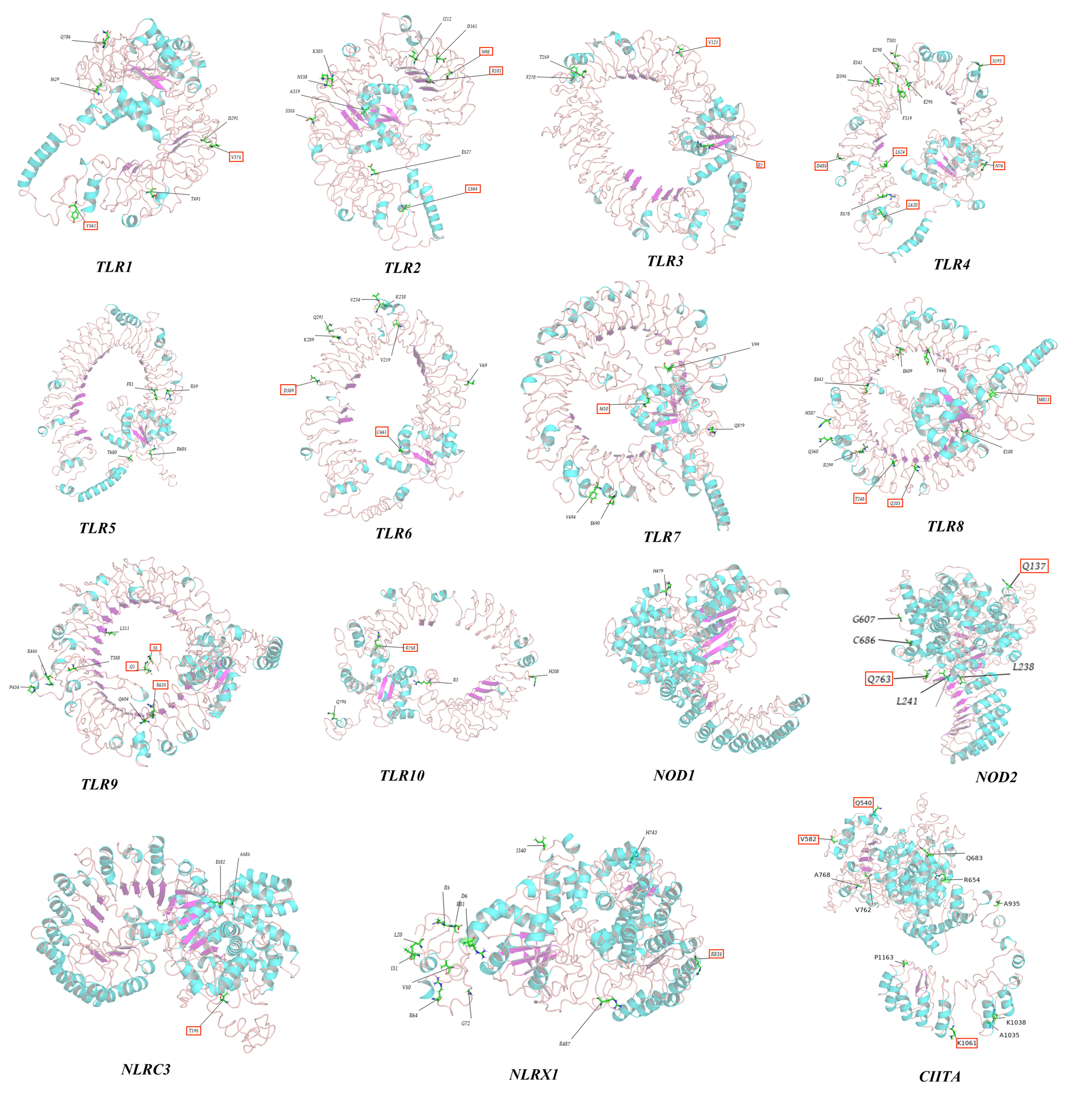
| Gene | Two ML | Three ML | Four ML | % of Sites (≥2 ML) |
|---|---|---|---|---|
| TLR1 | 5 | 1 | 0 | 0.76 |
| TLR2 | 6 | 3 | 1 | 1.26 |
| TLR3 | 2 | 1 | 1 | 0.44 |
| TLR4 | 5 | 4 | 3 | 1.44 |
| TLR5 | 4 | 0 | 0 | 0.47 |
| TLR6 | 8 | 0 | 0 | 1.01 |
| TLR7 | 5 | 0 | 0 | 0.48 |
| TLR8 | 8 | 2 | 0 | 0.96 |
| TLR9 | 4 | 1 | 3 | 0.78 |
| TLR10 | 2 | 0 | 2 | 0.49 |
| LGP2 | 1 | 1 | 3 | 0.74 |
| MDA5 | 15 | 2 | 2 | 1.85 |
| RIG-I | 10 | 0 | 3 | 1.4 |
| DECTIN1 | 3 | 0 | 0 | 1.22 |
| MEC1 | 1 | 2 | 0 | 0.21 |
| MRC2 | 10 | 1 | 3 | 0.97 |
| NOD1 | 1 | 0 | 0 | 0.1 |
| NOD2 | 6 | 0 | 0 | 0.59 |
| NLRX1 | 12 | 0 | 0 | 1.23 |
| CIITA | 6 | 5 | 0 | 0.91 |
| NLRC3 | 3 | 0 | 0 | 0.29 |
| NLRC5 | 6 | 6 | 4 | 0.86 |
| Model | np | LnL | ω for Branch | Model Compared | 2△LnL | p-Values |
|---|---|---|---|---|---|---|
| A: All the branch has same ω | 86 | −10,469.187 | ω = 0.54602 | |||
| B: All the branch has same ω = 1 | 85 | −10,516.988 | ω = 1 | B vs. A | 95.6024 | <0.01 |
| C: The branches with a pseudogenized TLR10 have the ω2; other branches have a ω1 | 87 | −10,459.788 | ω1 = 0.48586 ω2 = 0.96503 | C vs. A | 18.7986 | <0.01 |
| D: The branches with a pseudogenized TLR10 have the ω2 = 1; other branches have a ω1 | 86 | −10,459.816 | ω1 = 0.48608 ω2 = 1 | D vs. C | 0.056 | 0.8129 |
| Gene | Models | np | LnL | LRT p-Values | Positive |
|---|---|---|---|---|---|
| TLR1 | Model 1 null | 74 | −8759.05 | 0.237 | NA |
| Model 1 | 75 | −8758.35 | |||
| TLR2 | Model 1 null | 86 | −10,345.5 | 0.000801 | 301**V 454R |
| Model 1 | 87 | −10,339.9 | |||
| TLR3 | Model 1 null | 88 | −11,802.1 | 0.371 | NA |
| Model 1 | 89 | −11,801.7 | |||
| TLR4 | Model 1 null | 86 | −11,602.5 | 0.0000481 | 319F 395D 604*V |
| Model 1 | 87 | −11,594.3 | |||
| TLR5 | Model 1 null | 80 | −16,674.5 | 1 | Null |
| Model 1 | 81 | −16,674.5 | |||
| TLR6 | Model 1 null | 80 | −11,509.7 | 0.0727 | NA |
| Model 1 | 81 | −11,508.1 | |||
| TLR7 | Model 1 null | 82 | −11,828.6 | 1 | NA |
| Model 1 | 83 | −11,828.6 | |||
| TLR8 | Model A null | 80 | −14,115.5 | 1 | NA |
| Model 1 | 81 | −14,115.5 | |||
| TLR9 | Model 1 null | 78 | −15,197.2 | 0.842 | Null |
| Model 1 | 79 | −15,197.2 | |||
| TLR10 | Model 1 null | 74 | −9133.87 | 1 | NA |
| Model 1 | 75 | −9133.87 | |||
| LGP2 | Model 1 null | 86 | −9825.26 | 1 | Null |
| Model 1 | 87 | −9825.26 | |||
| MDA5 | Model 1 null | 82 | −12,345.3 | 0.182 | NA |
| Model 1 | 83 | −12,344.4 | |||
| RIG-I | Model 1 null | 86 | −11,151.2 | 0.000962 | NA |
| Model 1 | 87 | −11,145.7 | |||
| NOD1 | Model 1 null | 84 | −11,348.6 | 0.431 | Null |
| Model 1 | 85 | −11,348.3 | |||
| NOD2 | Model 1 null | 80 | −7349.27 | 0.48 | NA |
| Model 1 | 81 | −7349.02 | |||
| NLRC3 | Model 1 null | 72 | −13,289.7 | 0.842 | NA |
| Model 1 | 73 | −13,289.7 | |||
| NLRC5 | Model 1 null | 66 | −25,540.2 | 0.0021 | 931Q 1365*E 1366E |
| Model 1 | 67 | −25,535.5 | |||
| NLRX1 | Model 1 null | 84 | −13,104.4 | 1 | NA |
| Model 1 | 85 | −13,104.4 | |||
| CIITA | Model 1 null | 78 | −11,736.1 | 1 | NA |
| Model 1 | 79 | −11,736.1 | |||
| MRC1 | Model 1 null | 70 | −16,562.3 | 0.527 | NA |
| Model 1 | 71 | −16,562.1 | |||
| MRC2 | Model 1 null | 72 | −14,544.4 | 0.439 | Null |
| Model 1 | 73 | −14,544.1 | |||
| Dectin1 | Model 1 null | 80 | −3766.48 | 0.00414 | 115*F |
| Model 1 | 81 | −3762.37 |
Publisher’s Note: MDPI stays neutral with regard to jurisdictional claims in published maps and institutional affiliations. |
© 2022 by the authors. Licensee MDPI, Basel, Switzerland. This article is an open access article distributed under the terms and conditions of the Creative Commons Attribution (CC BY) license (https://creativecommons.org/licenses/by/4.0/).
Share and Cite
Wu, X.; Chen, J.; Wang, X.; Shang, Y.; Wei, Q.; Zhang, H. Evolutionary Impacts of Pattern Recognition Receptor Genes on Carnivora Complex Habitat Stress Adaptation. Animals 2022, 12, 3331. https://doi.org/10.3390/ani12233331
Wu X, Chen J, Wang X, Shang Y, Wei Q, Zhang H. Evolutionary Impacts of Pattern Recognition Receptor Genes on Carnivora Complex Habitat Stress Adaptation. Animals. 2022; 12(23):3331. https://doi.org/10.3390/ani12233331
Chicago/Turabian StyleWu, Xiaoyang, Jun Chen, Xibao Wang, Yongquan Shang, Qinguo Wei, and Honghai Zhang. 2022. "Evolutionary Impacts of Pattern Recognition Receptor Genes on Carnivora Complex Habitat Stress Adaptation" Animals 12, no. 23: 3331. https://doi.org/10.3390/ani12233331
APA StyleWu, X., Chen, J., Wang, X., Shang, Y., Wei, Q., & Zhang, H. (2022). Evolutionary Impacts of Pattern Recognition Receptor Genes on Carnivora Complex Habitat Stress Adaptation. Animals, 12(23), 3331. https://doi.org/10.3390/ani12233331





